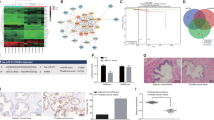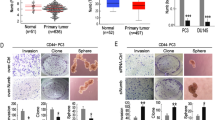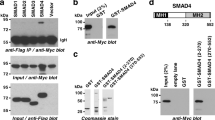Abstract
Epithelial–mesenchymal transition (EMT) is a developmental program of signaling pathways that determine commitment to epithelial and mesenchymal phenotypes. In the prostate, EMT processes have been implicated in benign prostatic hyperplasia and prostate cancer progression. In a model of Pten- and TP53-null prostate adenocarcinoma that progresses via transforming growth factor β-induced EMT, mesenchymal transformation is characterized by plasticity, leading to various mesenchymal lineages and the production of bone. Here we show that SLUG is a major regulator of mesenchymal differentiation. As microRNAs (miRs) are pleiotropic regulators of differentiation and tumorigenesis, we evaluated miR expression associated with tumorigenesis and EMT. Mir-1 and miR-200 were reduced with progression of prostate adenocarcinoma, and we identify Slug as one of the phylogenetically conserved targets of these miRs. We demonstrate that SLUG is a direct repressor of miR-1 and miR-200 transcription. Thus, SLUG and miR-1/miR-200 act in a self-reinforcing regulatory loop, leading to amplification of EMT. Depletion of Slug inhibited EMT during tumorigenesis, whereas forced expression of miR-1 or miR-200 inhibited both EMT and tumorigenesis in human and mouse model systems. Various miR targets were analyzed, and our findings suggest that miR-1 has roles in regulating EMT and mesenchymal differentiation through Slug and functions in tumor-suppressive programs by regulating additional targets.
This is a preview of subscription content, access via your institution
Access options
Subscribe to this journal
Receive 50 print issues and online access
$259.00 per year
only $5.18 per issue
Buy this article
- Purchase on Springer Link
- Instant access to full article PDF
Prices may be subject to local taxes which are calculated during checkout









Similar content being viewed by others
References
Thiery JP, Acloque H, Huang RY, Nieto MA . Epithelial–mesenchymal transitions in development and disease. Cell 2009; 139: 871–890.
Polyak K, Weinberg RA . Transitions between epithelial and mesenchymal states: acquisition of malignant and stem cell traits. Nat Rev Cancer 2009; 9: 265–273.
Gravdal K, Halvorsen OJ, Haukaas SA, Akslen LA . A switch from E-cadherin to N-cadherin expression indicates epithelial to mesenchymal transition and is of strong and independent importance for the progress of prostate cancer. Clin Cancer Res 2007; 13: 7003–7011.
Jaggi M, Nazemi T, Abrahams NA, Baker JJ, Galich A, Smith LM et al. N-cadherin switching occurs in high Gleason grade prostate cancer. Prostate 2006; 66: 193–199.
Alonso-Magdalena P, Brossner C, Reiner A, Cheng G, Sugiyama N, Warner M et al. A role for epithelial–mesenchymal transition in the etiology of benign prostatic hyperplasia. Proc Natl Acad Sci USA 2009; 106: 2859–2863.
Xu J, Lamouille S, Derynck R . TGF-beta-induced epithelial to mesenchymal transition. Cell Res 2009; 19: 156–172.
Ao M, Williams K, Bhowmick NA, Hayward SW . Transforming growth factor-beta promotes invasion in tumorigenic but not in nontumorigenic human prostatic epithelial cells. Cancer Res 2006; 66: 8007–8016.
Jones E, Pu H, Kyprianou N . Targeting TGF-beta in prostate cancer: therapeutic possibilities during tumor progression. Expert Opin Ther Targets 2009; 13: 227–234.
Adler HL, McCurdy MA, Kattan MW, Timme TL, Scardino PT, Thompson TC . Elevated levels of circulating interleukin-6 and transforming growth factor-beta1 in patients with metastatic prostatic carcinoma. J Urol 1999; 161: 182–187.
Wikstrom P, Stattin P, Franck-Lissbrant I, Damber JE, Bergh A . Transforming growth factor beta1 is associated with angiogenesis, metastasis, and poor clinical outcome in prostate cancer. Prostate 1998; 37: 19–29.
Burk U, Schubert J, Wellner U, Schmalhofer O, Vincan E, Spaderna S et al. A reciprocal repression between ZEB1 and members of the miR-200 family promotes EMT and invasion in cancer cells. EMBO Rep 2008; 9: 582–589.
Gregory PA, Bert AG, Paterson EL, Barry SC, Tsykin A, Farshid G et al. The miR-200 family and miR-205 regulate epithelial to mesenchymal transition by targeting ZEB1 and SIP1. Nat Cell Biol 2008; 10: 593–601.
Iliopoulos D, Lindahl-Allen M, Polytarchou C, Hirsch HA, Tsichlis PN, Struhl K . Loss of miR-200 inhibition of Suz12 leads to polycomb-mediated repression required for the formation and maintenance of cancer stem cells. Mol Cell 2010; 39: 761–772.
Shimono Y, Zabala M, Cho RW, Lobo N, Dalerba P, Qian D et al. Downregulation of miRNA-200c links breast cancer stem cells with normal stem cells. Cell 2009; 138: 592–603.
Martin P, Liu Y, Pierce R, Abou-Kheir WG, Casey O, Seng V et al. Prostate epithelial Pten/TP53 loss leads to transformation of multipotential progenitors and epithelial to mesenchymal transition. Am J Pathol 2011; 179: 422–435.
Hansel DE, Epstein JI . Sarcomatoid carcinoma of the prostate: a study of 42 cases. Am J Surg Pathol 2006; 30: 1316–1321.
Liu YN, Abou-Kheir W, Yin JJ, Fang L, Hynes P, Casey O et al. Critical and reciprocal regulation of KLF4 and SLUG in TGFbeta-initiated prostate cancer EMT. Mol Cell Biol 2011; 32: 941–953.
Wellner U, Schubert J, Burk UC, Schmalhofer O, Zhu F, Sonntag A et al. The EMT-activator ZEB1 promotes tumorigenicity by repressing stemness-inhibiting microRNAs. Nat Cell Biol 2009; 11: 1487–1495.
Lambertini E, Lisignoli G, Torreggiani E, Manferdini C, Gabusi E, Franceschetti T et al. Slug gene expression supports human osteoblast maturation. Cell Mol Life Sci 2009; 66: 3641–3653.
Torreggiani E, Lisignoli G, Manferdini C, Lambertini E, Penolazzi L, Vecchiatini R et al. Role of Slug transcription factor in human mesenchymal stem cells. J Cell Mol Med 2011; (e-pub ahead of print 7 June 2011; doi:10.1111/j.1582-4934.2011.01352.x.).
Molchadsky A, Shats I, Goldfinger N, Pevsner-Fischer M, Olson M, Rinon A et al. P53 plays a role in mesenchymal differentiation programs, in a cell fate dependent manner. PLoS One 2008; 3: e3707.
Chang CJ, Chao CH, Xia W, Yang JY, Xiong Y, Li CW et al. P53 regulates epithelial–mesenchymal transition and stem cell properties through modulating miRNAs. Nat Cell Biol 2011; 13: 317–323.
Wang SP, Wang WL, Chang YL, Wu CT, Chao YC, Kao SH et al. P53 controls cancer cell invasion by inducing the MDM2-mediated degradation of Slug. Nat Cell Biol 2009; 11: 694–704.
Casas E, Kim J, Bendesky A, Ohno-Machado L, Wolfe CJ, Yang J . Snail2 is an essential mediator of Twist1-induced epithelial mesenchymal transition and metastasis. Cancer Res 2011; 71: 245–254.
Ambs S, Prueitt RL, Yi M, Hudson RS, Howe TM, Petrocca F et al. Genomic profiling of microRNA and messenger RNA reveals deregulated microRNA expression in prostate cancer. Cancer Res 2008; 68: 6162–6170.
Datta J, Kutay H, Nasser MW, Nuovo GJ, Wang B, Majumder S et al. Methylation mediated silencing of microRNA-1 gene and its role in hepatocellular carcinogenesis. Cancer Res 2008; 68: 5049–5058.
Nasser MW, Datta J, Nuovo G, Kutay H, Motiwala T, Majumder S et al. Down-regulation of micro-RNA-1 (miR-1) in lung cancer. Suppression of tumorigenic property of lung cancer cells and their sensitization to doxorubicin-induced apoptosis by miR-1. J Biol Chem 2008; 283: 33394–33405.
Suzuki H, Takatsuka S, Akashi H, Yamamoto E, Nojima M, Maruyama R et al. Genome-wide profiling of chromatin signatures reveals epigenetic regulation of microRNA genes in colorectal cancer. Cancer Res 2011; 71: 5646–5658.
Ganem NJ, Compton DA . The KinI kinesin Kif2a is required for bipolar spindle assembly through a functional relationship with MCAK. J Cell Biol 2004; 166: 473–478.
Day CP, Carter J, Bonomi C, Esposito D, Crise B, Ortiz-Conde B et al. Lentivirus-mediated bifunctional cell labeling for in vivo melanoma study. Pigment Cell Melanoma Res 2009; 22: 283–295.
Abou-Kheir WG, Hynes PG, Martin PL, Pierce R, Kelly K . Characterizing the contribution of stem/progenitor cells to tumorigenesis in the Pten−/−TP53−/− prostate cancer model. Stem Cells 2010; 28: 2129–2140.
Ward Y, Lake R, Yin JJ, Heger CD, Raffeld M, Goldsmith PK et al. LPA receptor heterodimerizes with CD97 to amplify LPA-initiated RHO-dependent signaling and invasion in prostate cancer cells. Cancer Res 2011; 71: 7301–7311.
Yin J, Pollock C, Tracy K, Chock M, Martin P, Oberst M et al. Activation of the RalGEF/Ral pathway promotes prostate cancer metastasis to bone. Mol Cell Biol 2007; 27: 7538–7550.
Zhu M, Yi M, Kim CH, Deng C, Li Y, Medina D et al. Integrated miRNA and mRNA expression profiling of mouse mammary tumor models identifies miRNA signatures associated with mammary tumor lineage. Genome Biol 2011; 12: R77.
Acknowledgements
We acknowledge the support of the Intramural Research Program of the NIH, National Cancer Institute, Center for Cancer Research, USA. We thank Dr Chi-Ping Day, Dr Yvona Ward and Ross Lake for assistance.
Author information
Authors and Affiliations
Corresponding author
Ethics declarations
Competing interests
The authors declare no conflict of interest.
Additional information
Supplementary Information accompanies the paper on the Oncogene website
Rights and permissions
About this article
Cite this article
Liu, YN., Yin, J., Abou-Kheir, W. et al. MiR-1 and miR-200 inhibit EMT via Slug-dependent and tumorigenesis via Slug-independent mechanisms. Oncogene 32, 296–306 (2013). https://doi.org/10.1038/onc.2012.58
Received:
Revised:
Accepted:
Published:
Issue Date:
DOI: https://doi.org/10.1038/onc.2012.58
Keywords
This article is cited by
-
Prognostic and clinicopathological value of Slug protein expression in breast cancer: a systematic review and meta-analysis
World Journal of Surgical Oncology (2022)
-
Transcriptional and post-transcriptional control of epithelial-mesenchymal plasticity: why so many regulators?
Cellular and Molecular Life Sciences (2022)
-
Bile acids increase intestinal marker expression via the FXR/SNAI2/miR-1 axis in the stomach
Cellular Oncology (2021)
-
Noncoding RNAs in tumor metastasis: molecular and clinical perspectives
Cellular and Molecular Life Sciences (2021)
-
Ectopic expression of 35 kDa and knocking down of 78 kDa SG2NAs induce cytoskeletal reorganization, alter membrane sialylation, and modulate the markers of EMT
Molecular and Cellular Biochemistry (2021)



